China Fashion & Beauty
Fashion that Hurts? Online Debates on China’s Draft Law Regarding ‘Harmful’ Clothes
The proposed ban on clothing deemed harmful is stirring debate, with some arguing for the significance of protecting national pride and others emphasizing the value of personal expression.
Published
1 year agoon
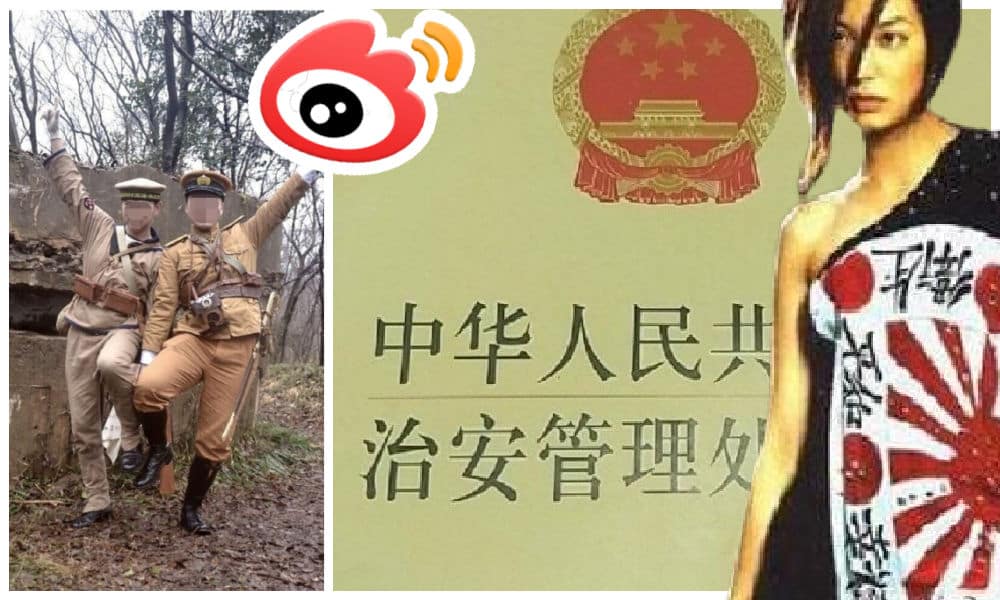
China’s recent proposal to ban clothing that “hurts national feelings” has triggered social media debates about freedom of dress and cultural sensitivities. The controversial amendment has raised questions about who decides what’s offensive for which reason.
A draft amendment to China’s Public Security Administration Punishments Law (治安管理处罚法) has caused some controversy this week for proposing a ban on clothes that “hurt national feelings.”
The discussions are about Article 34, clausules 3 and 4, which point out that wearing clothing or symbols that are deemed “harmful” to “the spirit and feelings of the Chinese nation” could become illegal. Offenders may face up to 15 days of detention and a fine of 5,000 yuan ($680).
The revised Article is part of a section about acts disrupting public order and their punishment, mentioning the protection of China’s heroes and martyrs.
Especially over the past three to four years, Chinese authorities have placed more importance on protecting the image of China’s “heroes and martyrs.” In 2018, the Heroes and Martyrs Protection Law was adopted to strengthen the protection of those who have made significant contributions to the nation and sacrificed their lives in the process.
Those insulting the PLA can face serious consequences. In 2021, former Economic Observer journalist Qiu Ziming (仇子明), along with two other bloggers, were the first persons to be charged under the new law as they were detained for “insulting” Chinese soldiers. Qiu, who had 2.4 million fans on his Weibo page, made remarks questioning the number of casualties China said it suffered in the India border clash. He was sentenced to eight months in prison.
Earlier this year, Chinese comedian Li Haoshi was canceled making a joke that indirectly made a comparison between PLA soldiers and stray dogs, while also placing words famously used by Xi Jinping in a ridiculous context.
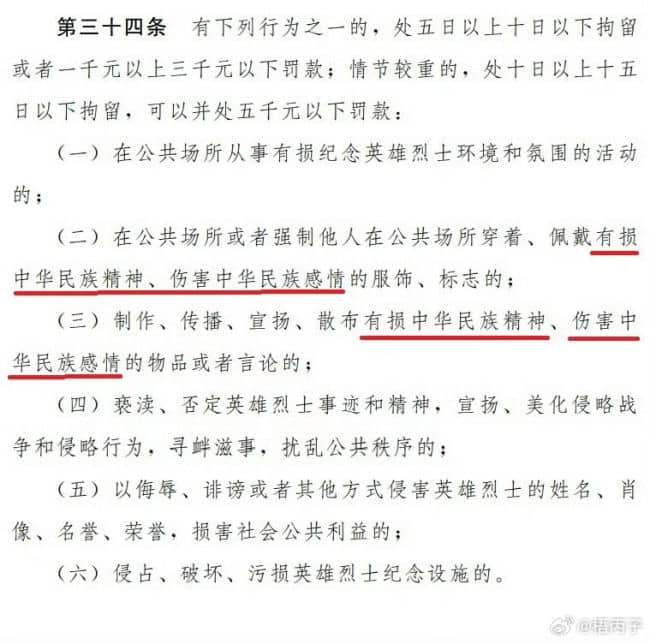
Screenshot of the draft widely shared on social media.
The draft is open for public comment through September 30, and it is therefore just a draft of a proposed amendment at this point.
Nevertheless, it has ignited many discussions on Chinese social media, where legal experts, bloggers, and regular netizens gave their views on the issue, with many people opposing the amendment.
This a translation of the first four clausules of Article 34 by Jeremy Daum’s China Law Translate (see the full translation here). Note that the discussions are focused on the item (2) and (3) revisions:
“Article 34:Those who commit any of the following acts are to be detained for between 5 and 10 days or be fined between 1,000 and 3,000 RMB; and where the circumstances are more serious, they are to be detained for between 10 and 15 days and may be concurrently fined up to 5,000 RMB:
(1) engaging in activities in public places that are detrimental to the environment and atmosphere for commemorating heroes and martyrs;
(2) Wearing clothing or bearing symbols in public places that are detrimental to the spirit of the Chinese people and hurt the feelings of the Chinese people, or forcing others do do so;
(3) Producing, transmitting, promoting, or disseminating items or speech that is detrimental to the spirit of the Chinese people and hurts the feelings of the Chinese people;
(4) Desecrating or negating the deeds and spirit of heroes and martyrs, or advocating or glorifying wars of aggression or aggressive conduct, provocation, or disrupting public order.”
Here, we mention the biggest online discussions surounding the draft amendment.
Main Objections to the Amendment
On Chinese social media site Weibo, commenters used various hashtags to discuss the recent draft, including the hashtags “China’s Proposed Amendment to the Public Security Administration Punishments Law” (#我国拟修订治安管理处罚法#), “Article 34 of the Draft Amendment to the Public Security Administration Punishments Law” (#治安管理处罚法修订草案第34条#) or “Harm the Feelings of the Chinese Nation” (#伤害中华民族感情#).
The issue that people are most concerned about is the vague definition “harming or hurting the spirit and feelings of the Chinese nation” (“伤害中华民族精神、感情”).
Although Chinese state media outlets, including the English-language Global Times, indicate that the clause is deemed to target some provocative actions to attract public attention, such as wearing Japanese military uniforms at sensitive sites, legal experts and social media users are expressing apprehensions regarding its ambiguity.
Questions arise: Who determines what qualifies as “harmful”? What criteria will be used? How will it be enforced? Beyond concerns about the absence of clear guidelines on which attire might be deemed illegal and for what reasons, there are fears of potential misinterpretation and misuse of such a law due to its subjective nature.
Some people question whether wearing foreign brands like Adidas or Nike could be considered offensive. There are also concerns about whether wearing sports attire supporting specific clubs might be seen as disrespectful. Another common topic is cosplay, a popular form of role-playing among China’s youth, where individuals dress up in costumes and accessories to portray specific characters. Can people still dress up in the way they like?
Well-known political commentator Hu Xijin published a video commentary about the issue on September 7, suggesting that the law in question could be more concrete and avoid misunderstanding by explicitly mentioning it targets facism, racism, or separatism. He also suggested that it is important for China’s legal system to provide people with a sense of security (– rather than scaring them).
Others reiterated similar views. If the clausules are indeed specifically about slandering national heroes and martyrs, which makes sense considering their context, they should be rephrased. One popular legal blogger (@皇城根下刀笔吏) wrote:
“The legal enforceability of harming the spirit and the feelings of the Chinese nation is not quite the same as insulting or slandering heroes. Because it is actually very clear who our national heroes are. They are classified as martyrs and were approved by the state, it’s very clear. But when it comes to the feelings and the spirit of the Chinese nation, this is just very vague (..) And ambiguity brings about a mismatch in the practice of implementation, which will make people lose trust in this legal provision and makes them feel unsafe.”
Although a majority of commenters agree that the proposed amendment is vague, some also express that they would support a ban on clothes that are especially offensive. Among them is the popular blogger Han Dongyan (@韩东言), who has over 2.3 million followers on Weibo.
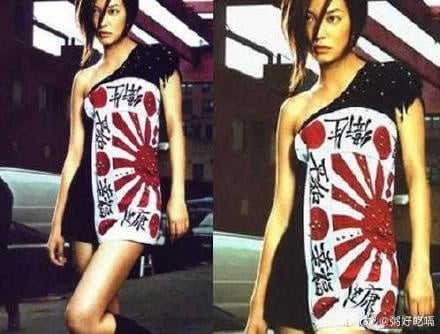
One example that is mentioned a lot, also by Han, is the 2001 controversy surrounding Chinese actress Vicky Zhao who wore a mini-dress printed with the old Japanese naval flag during a fashion shoot, triggering major backlash over her perceived lack of sensitivity to historical matters and the offensive dress.

Han also mentioned a 2018 example of two young men dressed in Imperial Japanese military uniforms taking a photo in front of the Shaojiashan Bunker at Zijin Mountain, where the Second Sino-Japanese War is commemmorated.
Kimono Problems
One trending story that is very much entangled with recent discussions about the proposed ban on ‘harmful’ clothing is that about a group of Chinese men and women who were recently denied access to the Panlongcheng National Archaeological Site Park in Wuhan because staff members allegedly mistook their clothing for Japanese traditional attire.
The individuals were actually not wearing Japanese traditional dress at all; they were wearing traditional Tang dynasty clothing to take photos of themselves. This is part of the Hanfu Movement, a social trend that is popular among younger people who supports the wearing of Han Chinese ethnic clothing (read more).
Amid discussions over draft law banning clothes harmful to the "spirit, feelings of the Chinese nation," this incident sparked discussions: Chinese wearing Tang clothes were denied entry at Panlongcheng Park, Wuhan, after local guard mistook their clothes for Japanese attire. pic.twitter.com/IokazvhBhl
— Manya Koetse (@manyapan) September 8, 2023
According to Zhengguan News (正观新闻), there is no official park policy prohibiting the wearing of Japanese clothing, and an internal investigation into the incident is ongoing. The Paper reported that the incident allegedly happened around closing time.
Meanwhile, this incident has sparked discussions because it highlights the potential consequences when authorities arbitrarily enforce clothing rules and misinterpret situations. One netizen wrote: “It illustrates that when “some members of the public” cannot even tell the difference between Hanfu, Tang dynasty attire, and Japanese kimono, they are simply venting their emotions.”
Last year, a Chinese female cosplayer who was dressed in a Japanese summer kimono while taking pictures in Suzhou’s ‘Little Tokyo’ area was taken away by local police for ‘provoking trouble’ (read here).
A young Chinese woman was taken away by local police in Suzhou last Wednesday because she was wearing a kimono. "If you would be wearing Hanfu (Chinese traditional clothing), I never would have said this, but you are wearing a kimono, as a Chinese. You are Chinese!" pic.twitter.com/et8vWOferQ
— Manya Koetse (@manyapan) August 15, 2022
A video showed how the young woman was scolded by an officer for wearing the Japanese kimono, suggesting she is not allowed to do so as a Chinese person. The girl was known to be a cosplayer, and she was dressed up as the character Ushio Kofune from the Japanese manga series Summer Time Rendering, wearing a cotton summer kimono, better known as yukata.
The incident sparked extensive debates, with differing viewpoints emerging. While some believed the girl’s choice of wearing Japanese clothing during the week leading up to August 15, a memorial day marking the end of the war, was insensitive, many commenters defended her right to engage in cosplay.
These discussions are resurfacing on Weibo, underscoring the divided opinions on the matter.
One Weibo user expressed a common viewpoint: “I believe wearing a Japanese kimono in everyday situations is not a problem, but doing so at specific times and places could potentially offend the sentiments of the Chinese nation.” Another blogger (@猹斯拉) also voiced support for a law that could prohibit certain clothing: “If you genuinely believe what you’re wearing is not harmful, you always have the right to make your argument.”
However, there is also significant opposition, with some individuals posting images of themselves reading George Orwell’s 1984 at night or making cynical remarks like, “Maybe we should say nothing and wear nothing, as anything else could lead to our arrest.”
“This is not progress,” another person wrote: “It’s taking another step back in time.”
By Manya Koetse
Follow @whatsonweibo
With contributions by Miranda Barnes
Get the story behind the hashtag. Subscribe to What’s on Weibo here to receive our newsletter and get access to our latest articles:
Spotted a mistake or want to add something? Please let us know in comments below or email us. First-time commenters, please be patient – we will have to manually approve your comment before it appears.
©2023 Whatsonweibo. All rights reserved. Do not reproduce our content without permission – you can contact us at info@whatsonweibo.com.
Manya is the founder and editor-in-chief of What's on Weibo, offering independent analysis of social trends, online media, and digital culture in China for over a decade. Subscribe to gain access to content, including the Weibo Watch newsletter, which provides deeper insights into the China trends that matter. More about Manya at manyakoetse.com or follow on X.

China Fashion & Beauty
“No Kimonos Allowed” – Ongoing Debate on Japanese Attire in China
A Chinese girl who was refused entry to a local comic convention for wearing a ‘kimono’ raised questions about whether restrictions on Japanese attire were motivated by historical sensitivities or gender bias.
Published
1 month agoon
August 1, 2024
An incident from earlier in July continues to spark discussions on Chinese social media about wearing Japanese-style clothing and where to draw the line between freedom of dress and banning attire deemed too sensitive.
The incident occurred in Jinan on July 20, when a girl wearing a Japanese yukata was refused entry to a local comic convention due to her attire. A yukata is similar to a kimono but more casual and lightweight, usually worn during the summer.
A video of the incident went viral, showing the girl dressed as Nezuko Kamado, a main character in the manga series Demon Slayer. The person filming, presumably the security guard at the venue, tells the girl she cannot enter dressed in a kimono and sends her away. “We don’t allow kimonos,” he says. “This is China.”

Screenshots of the video by RFA.
Although many applaud the decision to refuse Japanese traditional clothing at the convention, some commenters express frustration over such regulations at an anime convention, given that much of anime culture originates from Japan.
“With such a rule, why even bother holding an anime convention at all? Everything comes from Japan,” one top comment said.
“This is not even normal Japanese traditional clothing; it’s cosplay,” another person wrote.
Some people, however, point out that there are more cosplay events in China where dressing in Japanese-style attire goes against the rules, and suggest that this girl should have known better.
Sensitive Fashion
This is not the first time discussions over kimono-wearing women have flared up in China. One notable incident happened in the summer of 2022, when a Chinese female cosplayer dressed in a Japanese summer kimono while taking pictures in Suzhou’s ‘Little Tokyo’ area was taken away by local police for ‘provoking trouble’ (read more).
Later, in September 2023, a draft amendment to China’s Public Security Administration Punishments Law (治安管理处罚法) to ban clothing that “hurts national feelings” also triggered social media debates about freedom of dress and cultural sensitivities.
The issue that concerned people the most was the vague definition included in the amendment, namely, “harming or hurting the spirit and feelings of the Chinese nation” (“伤害中华民族精神、感情”). Although Chinese state media indicated that the clause targets provocative actions to attract public attention, such as wearing Japanese military uniforms at sensitive sites, legal experts and social media users expressed apprehensions regarding its ambiguity, wondering who determines what qualifies as “harmful” in the end.
Among Chinese young people, cosplay (‘costume play’) has become increasingly popular in recent years. Cosplay allows people to be something they are not—a superhero, a villain, a sex bomb—sometimes Chinese, American, or Japanese. Would a change to the law prevent them from role-playing?
A Gender Issue
Some people suggest that this is not only about wearing Japanese-style clothing but also about sexist ideas in China regarding what Chinese women can or cannot wear.
One Weibo user (@我见青山多可笑) thought it was especially unfair for the girl in Jinan to be denied entry in light of another recent incident where a man wearing a t-shirt with a Rising Sun flag design visited the Unit 731 Exhibition Hall, a museum about the biological and chemical warfare atrocities committed by the Japanese in Harbin during the Second Sino-Japanese War.
That incident happened on July 14. Although other visitors at the museum took offense and photographed the man wearing the t-shirt, nobody intervened. On Weibo, wearing such a t-shirt to the war museum was seen as an act of provocation (#男子在731部队罪证陈列馆穿太阳旗图案T恤#).

A man wearing a Japanese rising sun design while visiting a museum about war atrocities committed by Japanese in Harbin.
The Weibo user wrote: “This just shows that people’s sensitivity to Japanese clothing/Japanese culture is entirely divided by gender. If it’s a woman, it’s not allowed. If it’s a guy? Absolutely fine!”
Other commenters (@超级大酵母母母) agreed, saying: “The girl wasn’t wearing a traditional kimono; it was a cosplay outfit of a character. There were many male characters in Japanese-style clothing at the convention, but security did not stop them and only stopped the girl.”
In the end, regardless of political and gender implications, Chinese cosplay fans are just worried about the future of their beloved hobby: “If kimonos are not allowed at anime conventions, then there are so many characters that can’t be cosplayed. It’s just ridiculous!”
By Manya Koetse
Spotted a mistake or want to add something? Please let us know in comments below or email us. First-time commenters, please be patient – we will have to manually approve your comment before it appears.
©2024 Whatsonweibo. All rights reserved. Do not reproduce our content without permission – you can contact us at info@whatsonweibo.com.
China Brands, Marketing & Consumers
Chinese Sun Protection Fashion: Move over Facekini, Here’s the Peek-a-Boo Polo
From facekini to no-face hoodie: China’s anti-tan fashion continues to evolve.
Published
3 months agoon
June 6, 2024
It has been ten years since the Chinese “facekini”—a head garment worn by Chinese ‘aunties’ at the beach or swimming pool to prevent sunburn—went international.
Although the facekini’s debut in French fashion magazines did not lead to an international craze, it did turn the term “facekini” (脸基尼), coined in 2012, into an internationally recognized word.
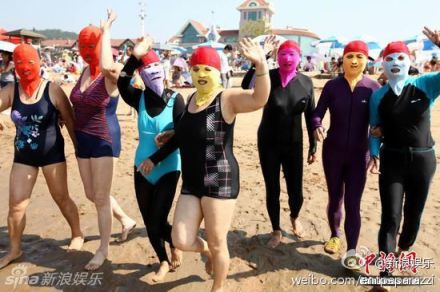
The facekini went viral in 2014.
In recent years, China has seen a rise in anti-tan, sun-protection garments. More than just preventing sunburn, these garments aim to prevent any tanning at all, helping Chinese women—and some men—maintain as pale a complexion as possible, as fair skin is deemed aesthetically ideal.
As temperatures are soaring across China, online fashion stores on Taobao and other platforms are offering all kinds of fashion solutions to prevent the skin, mainly the face, from being exposed to the sun.

One of these solutions is the reversed no-face sun protection hoodie, or the ‘peek-a-boo polo,’ a dress shirt with a reverse hoodie featuring eye holes and a zipper for the mouth area.

This sun-protective garment is available in various sizes and models, with some inspired by or made by the Japanese NOTHOMME brand. These garments can be worn in two ways—hoodie front or hoodie back. Prices range from 100 to 280 yuan ($13-$38) per shirt/jacket.

The no-face hoodie sun protection shirt is sold in various colors and variations on Chinese e-commerce sites.
Some shops on Taobao joke about the extreme sun-protective fashion, writing: “During the day, you don’t know which one is your wife. At night they’ll return to normal and you’ll see it’s your wife.”

On Xiaohongshu, fashion commenters note how Chinese sun protective clothing has become more extreme over the past few years, with “sunburn protection warriors” (防晒战士) thinking of all kinds of solutions to avoid a tan.

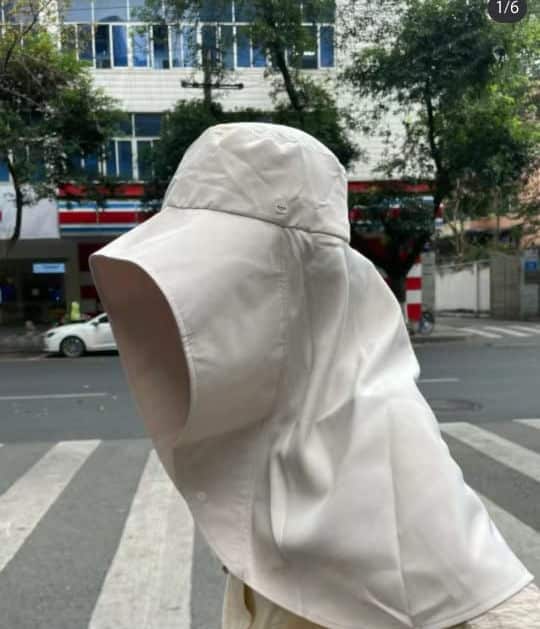


Although there are many jokes surrounding China’s “sun protection warriors,” some people believe they are taking it too far, even comparing them to Muslim women dressed in burqas.
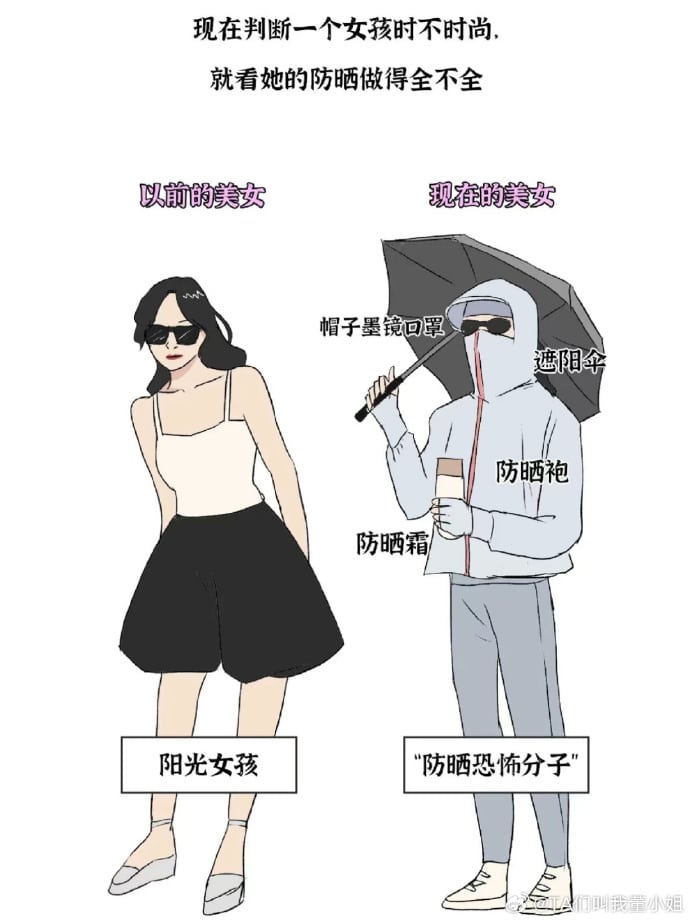
Image shared on Weibo by @TA们叫我董小姐, comparing pretty girls before (left) and nowadays (right), also labeled “sunscreen terrorists.”
Some Xiaohongshu influencers argue that instead of wrapping themselves up like mummies, people should pay more attention to the UV index, suggesting that applying sunscreen and using a parasol or hat usually offers enough protection.
By Manya Koetse, with contributions by Miranda Barnes
Spotted a mistake or want to add something? Please let us know in comments below or email us. First-time commenters, please be patient – we will have to manually approve your comment before it appears.
©2024 Whatsonweibo. All rights reserved. Do not reproduce our content without permission – you can contact us at info@whatsonweibo.com.
Subscribe

Weibo Watch: The Land Rover Woman Controversy Explained

China at the 2024 Paralympics: Golds, Champions, and Trending Moments

“Land Rover Woman” Sparks Outrage: Qingdao Road Rage Incident Goes Viral in China

Fired After Pregnancy Announcement: Court Case Involving Pregnant Employee Sparks Online Debate

Weibo Watch: Going the Wrong Way

Saying Goodbye to “Uncle Wang”: Wang Wenbin Becomes Chinese Ambassador to Cambodia

Hero or Zero? China’s Controversial Math Genius Jiang Ping

A Triumph for “Comrade Trump”: Chinese Social Media Reactions to Trump Rally Shooting

Why Chinese Publishers Are Boycotting the 618 Shopping Festival

Chinese Sun Protection Fashion: Move over Facekini, Here’s the Peek-a-Boo Polo

About Wang Chuqin’s Broken Paddle at Paris 2024

The Beishan Park Stabbings: How the Story Unfolded and Was Censored on Weibo

China’s 2024 Gaokao Triggers Online Discussions on AI

China at Paris 2024 Olympics Trend File: Medals and Moments on Chinese Social Media

Stolen Bodies, Censored Headlines: Shanxi Aorui’s Human Bone Scandal
Get in touch
Would you like to become a contributor, or do you have any tips or suggestions? Get in touch here!
Popular Reads
-

 China Insight4 months ago
China Insight4 months agoThe Tragic Story of “Fat Cat”: How a Chinese Gamer’s Suicide Went Viral
-

 China Music5 months ago
China Music5 months agoThe Chinese Viral TikTok Song Explained (No, It’s Not About Samsung)
-

 China Digital11 months ago
China Digital11 months agoToo Sexy for Weibo? Online Discussions on the Concept of ‘Cābiān’
-

 China Insight6 months ago
China Insight6 months agoThe ‘Two Sessions’ Suggestions: Six Proposals Raising Online Discussions




